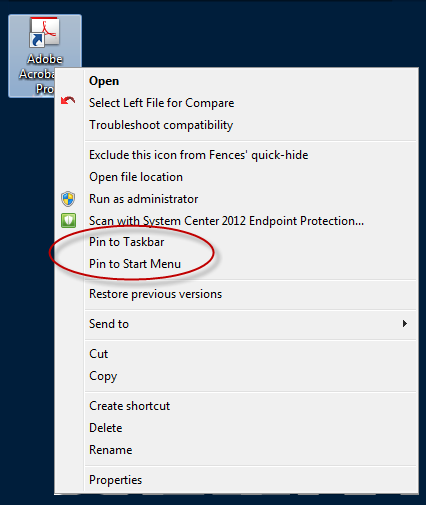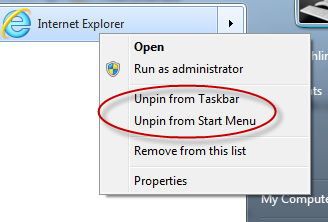When selecting User Start Menu (Pin) or User Taskbar (Pin) with a non-English language workstation operating system, you must define a variable that defines the non-English verbiage to substitute in place of the English "Pin To..." verbiage. The value of these variables should match the "Pin to Taskbar" or "Pin to Start Menu" text on the popup menu of a program shortcut. The following variables can be defined as User Management Global Variables or as a Profile Definition Variable.
Figure 2: Example of "Pin to" options

For the Unpin variables, the value should match the "Unpin from Taskbar" or "Unpin from Start Menu" on the popup menu of a shortcut on the Start Menu or Taskbar.
Figure 3: Example of "Unpin from" options

Defines the "Pin to Taskbar" verbiage on non-English client operating systems.
| Example (German language operating system): $PinToTaskbarString = "GermanLanguage" where GermanLanguage will be replaced with the German language equivalent |
Defines the "Unpin from Taskbar" verbiage on non-English client operating systems.
| Example (German language operating system): $UnPinFromTaskbarString = "GermanLanguage" where GermanLanguage will be replaced with the German language equivalent |
Defines the "Pin to Start Menu" verbiage on non-English client operating systems.
| Example (German language operating system): $PinToStartMenuString = "GermanLanguage" where GermanLanguage will be replaced with the German language equivalent |
Defines the "Pin to Start Menu" verbiage on non-English client operating systems.
| Example (German language operating system): $UnPinFromStartMenuString = "GermanLanguage" where GermanLanguage will be replaced with the German language equivalent |
The Web Browser object allows for the configuration of custom Firefox settings. If you wish to configure something in the Firefox browser that is not offered on the Web Browser object, it can be configured in the Global or Profile Definitions.
Use the following syntax for configuration:
This will set the named Firefox preference to the given value. This configuration can be accessed via the browser and changed by the user.
This will set the named Firefox preference to the given value. This configuration will not be able to be changed via the browser about:config dialog by the user.
"Name" is the name of the preference to be set.
Value is the boolean, string, or integer data for the preference.
Preferences and their settings can be seen in Firefox's about:config dialog.
note: Custom Firefox preferences can be researched in this reference to the user preferences in the about:config,
Bool Value: - value can be true or false
AddCustomFirefoxPref('pref("privacy.clearonshutdown.cache", true);')
String Value: - add double quotes around value
AddCustomFirefoxPref('pref("network.automatic-ntlm-auth.trusted-uris", "Http://www.google.com");')
Integer Value: - a numeric value
AddCustomFirefoxPref('pref("network.http.connection-retry-timeout", 500);')
Locked Integer Value: (to prevent a setting from being changed by the user, replace pref with lockpref)
AddCustomFirefoxPref('lockPref("network.http.connection-retry-timeout", 500);')
This setting will enable Validation Logic to validate on any IP address defined for the client, instead of just the first one read. This variable can be defined as a User Management Global Variable or as a Profile Definition Variable.
| Example: $VLCheckAllIPAddresses = 1 |
Sometimes, on large database transactions, the default SQL Command timeout value is not big enough to support the command, allowing the transaction to timeout and fail. Creating this new registry key allows this timeout value to be overridden and increased to alleviate a timeout problem.
| Name | Type | Data |
|---|---|---|
| HKEY_LOCAL_MACHINE\SOFTWARE\ScriptLogic\SqlCommandTimeout | DWORD | specified in seconds |